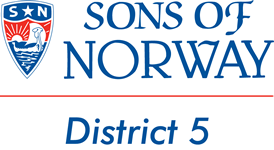Cultural Corner
Sons of Norway Book Club 2025
Jan. 23, 2025 The Rocks Will Echo The Rabbit Factor (Rabbit Factor series #1)
UPDATED Our Sorrow by Antti Tuomainen
The Forced Displacement
------------------------------
Feb. 27, 2025 We are Going to Pick Potatoes: Sidetracked
------------------------------
Mar. 27, 2025 King Harald’s Saga The Raven
by Vidar Sundstol
------------------------------
April 24, 2025 Norse Mythology The Iron Chariot
------------------------------
send an email with your name, lodge name and contact information (phone number and email address)
to SonsofNorwayBookClub@gmail.com
Steps for obtaining rewards for the Cultural Arts Programs
1. member completes requirements for a given cultural skill.
2. member submits completed project including written work and photos to local lodge cultural director or other lodge officer if there is no cultural director.
3. local cultural director or officer confirms that the project is complete.
4. local cultural director or officer orders reward pin, medal or bar.
5. award is presented at a lodge meeting.
It is suggested that several pins or bars be ordered at the same time since the cost of shipping and handling is the same for one pin or a dozen. Cultural pins and sports pins can be ordered at the same time.
If a lodge or individual prefers not to use pins/bars as rewards, a recognition certificate can be downloaded from the sofn.com site as a substitute.
Judy Ghastin
District 5 Cultural Director
Care and Feeding of the Viking Chest
CARE
Specialists in various Scandinavian crafts have been and are being consulted concerning the most protective way to stow contributions in the Viking Chest.
*Please avoid extreme temperatures when choosing a place to keep the chest.
*In general, AVOID PLASTIC.
*Hardanger embroidery should be wrapped in tissue and rolled on a cardboard tube.
*Rosemaling and painted items can be stored in a soft cloth bag
*Wood carvings can be stored in a soft cloth bag.
*Knitted or fabric items store well in a soft cloth bag.
A cloth bag may be stitched up from an old sheet or pillowcase.
FEEDING
*Contribute something to the Viking Chest which is meaningful to your lodge in some way. A small or medium size item is recommended.
*When an item is added to the Chest, please tell about it in a brief written statement included with the item.. Identify the maker if known. Tell how the item represents your lodge or other information about it.
*Please fill out the contributor's record sheet giving the lodge name, date and any other information requested.
*Please email the registration information and description of your item to the Cultural Director, judy62ghastin@gmail.com
for ongoing record keeping of the contents of the Viking Chest.
Tusen takk to all for helping to keep the Viking Chest project growing.
Judy Ghastin
District 5 Cultural Director
May 2014 Item of the Month The Viking Raven Banner
The May 2014 Item of the Month is the Viking Raven Banner.
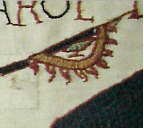 The Viking Raven Banner, hrafnsmerki in Old Norse, was used by Norsemen from the 9th to the 11th C. It is roughly triangular with a rounded outside edge and tassels or tabs. It resembles weather vanes on longships or longhouses. It may be a symbol of Odin and his two ravens Huginn and Muninn.
The Viking Raven Banner, hrafnsmerki in Old Norse, was used by Norsemen from the 9th to the 11th C. It is roughly triangular with a rounded outside edge and tassels or tabs. It resembles weather vanes on longships or longhouses. It may be a symbol of Odin and his two ravens Huginn and Muninn.
The Raven Banner is mentioned throughout the Viking Age. It is mentioned in the Anglo Saxon Chronicle, 878. A penny minted by Olaf Cuaran in 940 has an image of the banner. Norsemen in Dublin and Northumbria used the banner in the 10th C, as well as the Jarls of Orkney. In the Orkneyinga Saga, victory came to those who followed the banner, but death came to the one who carried the banner. Cnut the Great carried the banner at the Battle of Ashingdon 1016, and Harald Hardrada flew the banner at the Battle of Stamford Bridge, which is depicted on the Bayeux Tapestry.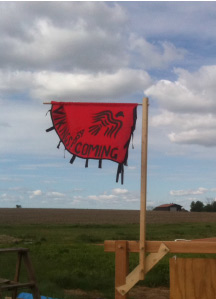
Today the Raven Banner is used in the Shetlands as a symbol of Up-Helly-Aa, and by some members of the Sons of Norway.
April 2014 Item of the Month The Budstikke
The April 2014 Item of the Month is the Budstikke.
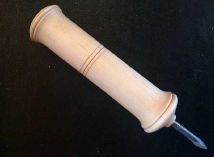 Figure 1. The Budstikke. This Budstikke was made by Bayard the Turner in the SCA, our Mediavel Re-enactment Group.
Figure 1. The Budstikke. This Budstikke was made by Bayard the Turner in the SCA, our Mediavel Re-enactment Group.
The Budstikke was used since the Viking Age to send messages or rally people in rural areas. Sometimes messages were marks or runes on wood, other times the budstikke was hollowed and a message placed inside. The Budstikke was passed from farm to farm. If people were not home, the budstikke would be jammed into the door or into the door jam. When the people arrived home they would pass the budstikke onto the next farm.
In Viking times, about 950 AD, the Norwegian king Haakon the Good used the Budstikke to call people to defend the land.Besides the rural areas of Norway, budstikker were used throughout Scandinavia, and in Scotland and the Faroe Islands. Recently the word Budstikke has been used as a name for newspapers and newsletters.
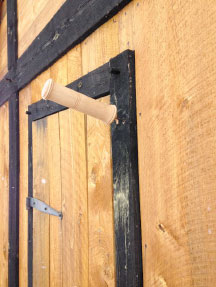
March 2014 Item of the Month Viking Age Pole Lathe Turned Bowl
The March 2014 Item of the Month is the Viking Age pole lathe turned bowl.
The March Item of the Month is a continuation of the January and February Items of the Month. In January we saw the shape of Viking Age bowl. In February we saw how bowls were turned on a pole lathe. This month we see a bowl turned on a pole lathe, see the above figure. Scandinavians and Scandinavian Immigrants continue to enjoy a bowl turning tradition with the ale bowl. Even today some of these ale bowls are turned on a pole lathe.
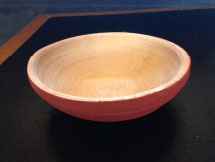 This bowl is birch. The outside is painted with red colored milk paint, a combination of milk, lime and earthen pigments. Wood was painted in the Viking Age1 possibly with milk paint.
This bowl is birch. The outside is painted with red colored milk paint, a combination of milk, lime and earthen pigments. Wood was painted in the Viking Age1 possibly with milk paint.
1 Carole A. Morris, Wood and Woodworking in Anglo-Scandinavian and Medieval York, Published for the York Archaeological Trust by the Council for British Archaeology, Vol 17: The Small Finds, Fasc. 13. Craft, Industry, and Everyday Life, ISBN 1 902771 10 9, 2360.
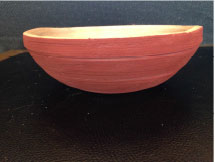
February 2014 Item of the Month Viking Age Pole Lathe
The February 2014 Item of the Month is the Viking Age pole lathe.
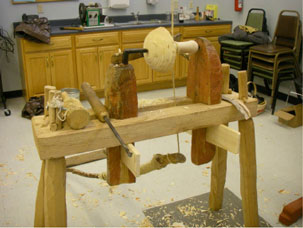
Figure 1. The Viking Age pole lathe.
The height of bowl making was from 500 to 1500 AD. Robin Wood, a Welsh turner, believes that the pole lathe was the tool designed to make bowls.1 Other methods of bowl making pale in terms of efficiency and beauty, in my opinion.
Scandinavians and Scandinavian Immigrants continue to enjoy a bowl turning tradition with the ale bowl. Even today some of these ale bowls are turned on a pole lathe.
With a pole lathe, the operator stands behind the lathe to depress the foot pedal. A rope attached to the foot pedal is wrapped around a mandrel mounted on a bowl blank, and it turns the bowl mounted between the two turning centers on the pole lathe. The rope is attached to a pole which provides the restoring force to pull the foot pedal upwards in preparation for the next cut and turn of the bowl. The operator uses a hook knife to carve the turning bowl.
1 Robin Wood, The Wooden Bowl, Stobart Davies Ltd, 2005, page 16.
January 2014 Item of the Month Viking Age Bowl
The January 2014 Item of the Month is a Viking Age bowl.
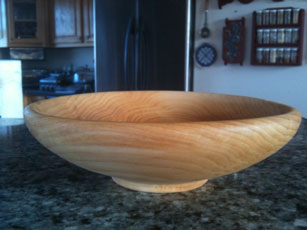
Figure 1. The Viking Age bowl.
Yes, you too can eat like a Viking. All you need is a bowl. Until about the 16th century most people, including the Vikings from an earlier period, ate out of wooden bowls.1
What do Viking Age bowls look like? Robin Woods The Wooden Bowl,2 and Carole Morriss Wood and Woodworking in Anglo-Scandinavian and Medieval York3 are fantastic references for medieval and Viking bowls. I made a replica of a medieval bowl, a Coppergate bowl, Morris's bowl number 8571, page 2171.4
I made the bowl out of Basswood (Tilia Americana, also known as Linden, which is a light, soft hardwood often used in Norwegian ale bowls and used for carving), and finished it in walnut oil and beeswax. Some Basswood is cream colored, but this Basswood is tan colored, in some ways similar in color to willow. (The wood used in bowls and cups in York were commonly alder, maple, and birch with a few examples from several other wood species.5)
Now I can truly enjoy my skyr and rommegrot like a Viking.
1 Robin Wood, The Wooden Bowl, Stobart Davies Ltd, 2005, page 59, 129-130. 2 Robin Wood, The Wooden Bowl, Stobart Davies Ltd, 2005. 3 Carole A. Morris, Wood and Woodworking in Anglo-Scandinavian and Medieval York, Published for the York Archaeological Trust by the Council for British Archaeology, Vol 17: The Small Finds, Fasc. 13. Craft, Industry, and Everyday Life, ISBN 1 902771 10 9, 2000. 4 Morris, page 2171. 5 Morris, page 258.
December 2013 Item of the Month Tassie Tamper
The December 2013 Item of the Month is the Tassie Tamper, and Coffyngs and Trapes.
For this Jul season I chose the Tassie Tamper as the Item of the Month. One of my favorite Christmas baking goodies is the Golden Pecan Tassie. It is a tart made with a nut filling. Elspeth uses a tool called a tassie tamper to spread dough in tart pans. It consists of a two truncated spheres attached to a cylindrical handle. I made two tassie tampers shown in the photo along with the original on the right.
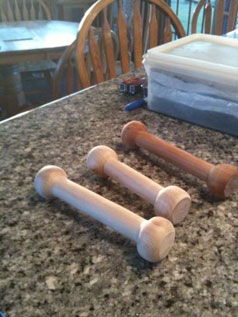
Figure 1. The Tassie Tamper
The origin of the tassie tamper is obscure. One cooking website, taste of home, gives the following information on the tarts or tassies:
No one knows for sure where tassies originated.
There is basically no information on the history in cookbooks or cooking sites. This is the closest information that can be found in a couple of Webster's dictionaries ...?? Tasses or tassets: from the French word 'tassette'...a small pocket, pouch, or small cup.? tasse (noun): [perhaps from Middle French tasse purse, pouch] First appeared circa 1548?? Tasses: French Term: moule à timbale? Phraseology: beurrer les moules à timbale ou des tasses.?? Someone else wrote that tassies are old Scottish for "little cups."?
Websters gives a date of 1548 for tassies. Maybe we can derive or induce some information from medieval tart pans or pie pans. A tassie tamper would not predate a tart tin, so if we could find information about tart or pie tins, that might give us a reasonable date of origin, or at least a date before which we would not expect to find a tassie tamper. From To The Kings Taste by Lorna Sass, based on the Forme of Cury (Manner of Cookery) written in 1390 at the request of King Richard II, we find:
Page 11: Take and make a foyle [leaf] of gode past with a roller, of a foot brode, and lynger by cumpas [in proportion]. Make foure coffyngs [pie crusts] of the self [same] past upon the rollers, the gretnesse of the smale of thyn arme, of six ynche deepnesse.
Page 129: coffin a mold of pastry for a pie.
So the pie crust or pastry is called a coffyng or coffin. But what about the pie pan?
Page 48:
Tart de Bry Take a crust ynche depe in a trape.
Brie Tart Take a crust an inch deep in a baking dish.
Our dough is past, which makes the crust or coffyng, and a baking dish is a trape, all from 1390.
This does not tell us when a tassie tamper was first used, but possibly as early as tart pans were used, which was prior to 1390 when their use was recorded in the Forme of Cury. Nevertheless, this suggests that a tassie tamper could have originated in Medieval times.
There you have it, from Scandinavian Holiday baking, to turning, to a Tassie Tamper and a coffyng and a trape dating from 1390. Thats a journey of six countries and six hundred years, all to produce a turned kitchen implement for our Christmas baking. Talk about an exciting journey through time and space.
November 2013 Item of the Month The Lefse Turner
The November 2013 Item of the Month is the lefse turner.
Lefse is uniquely Scandinavian, popular during holidays in America such as Thanksgiving, Christmas, and Easter. Widely know to impart the cool calculating logic and analytic skills that the Norse are known for, lefse was invented when potatoes were introduced to Norway in the mid 18th century. Today lefse is loved and eaten by Norwegians and by Scandinavian immigrants in America.
Lefse is made on a large flat griddle, and is flipped with a lefse turner. Most lefse turners are thin and curved or rounded. My lefse turner is shown in the following photograph.
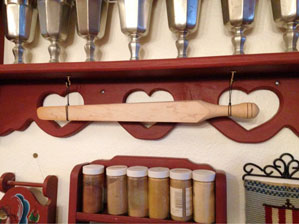
My lefse turner is thin at the point, and much thicker toward the turned handle. At first one might think this would make turning the lefse difficult, but in fact the thick end and its angle naturally lift the lefse off the griddle making flipping the lefse quite easy.
The origin of lefse must be traced to Scandinavian flat bread which goes back past the Viking Age. The lefse turner works well for most medieval and ancient flat bread.
October 2013 Item of the Month The Outhouse
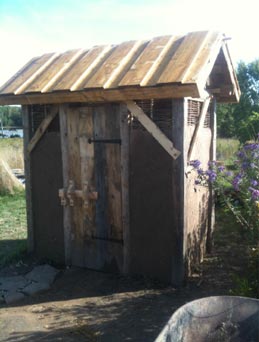 Throughout human history, as man became farmers and began building civilizations with cities and towns, the outhouse has been an innovation promoting hygiene and cleanliness. Outhouses have continued to be used into the 20th and 21st centuries. I remember quite vividly my grandparents outhouse, a two holer, on hot summer days and cool October mornings.
Throughout human history, as man became farmers and began building civilizations with cities and towns, the outhouse has been an innovation promoting hygiene and cleanliness. Outhouses have continued to be used into the 20th and 21st centuries. I remember quite vividly my grandparents outhouse, a two holer, on hot summer days and cool October mornings.
Since this month is October with Halloween at the end of the month, it seems fitting to include a ghost story. This story was submitted to the Northwatch, a Society for Creative Anachronism regional publication. It is re-telling of one of the Vinland stories with a modern interpretation, and an outhouse figures prominently in the story.
Ghost Story from the Vinland Sagas:
Death of Thorstein Eiriksson and Grimhild/Sigrid
Thorstein Eiriksson, brother of Leif the Lucky, and his wife, Gudrid, turned back after an unsuccessful attempt to reach Vinland and found themselves in Greenland just before winter, by the Christian calendar the middle of October. Thorstein the Black invited them to stay at his farm with his wife, Grimhild. Thorstein Eiriksson accepted the invitation.
Soon, as cold weather set in, illness spread through the crew and reached the farm where both Thorstein Eiriksson and Grimhild fell ill, but Gudrid, and Thorstein the Black, remained well.
One night Grimhild asked Gudrid to accompany her to the outhouse, which was positioned opposite the main door. As they turned to go back into the longhouse, Grimhild utter a surprised exclamation. Gudrid asked Grimhild what was wrong. Grimhild said she saw dead family and friends lined up across the front of the longhouse, including herself and Thorstein. Then the apparition disappeared and she was herself again.
After returning to the longhouse, Grimhild went back to bed and died that evening.
The next day Grimhilds corpse crawled out of the bed and tried to get into bed with Thorstein Eiriksson. Thorstein the Black took an axe and smote the corpse in her heart.
By nightfall Thorstein Eiriksson died. Thorstein the Black consoled Gudrid and promised to take Thorsteins body back to Erik the Reds farm, Brattalid, in Greenland, to be buried in the church yard there.
At that point Thorstein Eiriksson sat up in bed and called for Gudrid. He said he had been granted a short time to talk with his wife. First he had some words he whispered to Gudrid. Then he said that Gudrid would marry again, but not a Greenlander. Her future lay in Iceland.
Thorstein the Black kept his promise to Gudrid. That spring, he sold his farm and took Gudrid and Thorsteins body back to Brattalid. He bought a small farm near Brattalid, and settled there.
Gudrid met Thorfinn Karlsefni, a merchant and ship owner from Iceland, at Brattalid the next winter and married him. With her marriage, Gudrid began her Vinland adventures.
-----------------------------------------------------
Afterword: The two versions of Thorstein Eirikssons death in the Vinland Sagas are slightly different. In The Greenlanders saga, Thorstein Eiriksson and Gudrid return to Greenland in the fall after being driven off course to Ireland, and spend the winter with Thorstein the Black and Grimhild. In Eiriks saga, Thorstein Eiriksson and Gudrid spend the winter at a farm Thorstein Eiriksson owned with Thorstein the Black and his wife, who in this version is called Sigrid. In both stories, sickness spreads through the men as winter weather sets in. Both stories have Thorstein the Blacks wife (Grimhildr/Sigrid) dying and her corpse attempting to crawl out of bed, and then Thorstein Eiriksson dies, but shortly afterward, he rises briefly and speaks to his wife Gudrid, foretelling her future.
In Iceland, it was believed that a persons corpse could be animated and could walk around and talk. This prompted the practice of driving a stake through the heart of the corpse buried in the ground, and later the stake would be removed and a priest would pour holy water into the cavity.
The description of the sickness and symptoms described in the sagas suggest the illness that killed Grimhildr/Sigrid and Thorstein Eiriksson may have been typhus. Described as the cause of an epidemic in Oxford in 1485, typhus was probably widespread throughout Europe in the Middle Ages. Some believe the Plague of Athens during the Peloponnesian War was also typhus. Epidemic typhus carried by body lice and fleas had a high mortality rate. Typhus affected people in cold and crowded conditions such as prisons and army winter camps. The incubation period is almost two weeks. The illness begins with fever and muscle pain, which are followed by hallucinations, stupor and death.
Lets see how typhus may fit the description of the illness in these two sagas:
In the Greenlanders saga, the men had returned from a trip where they could have picked up lice. Then with cold weather, the men would be further confined together in houses where lice could spread resulting in illness a few weeks after their arrival.
The high mortality matches epidemic typhus.
The visions of dead family and friends are consistent with typhus- induced hallucinations.
The apparent death and reanimation of the corpse of both Grimhild and Thorstein Eiriksson could be explained if stupor due to typhus was mistaken for death.
Is it possible that Thorstein Eiriksson and Grimhild/Sigrid contracted and died from typhus? We believe that it is indeed possible. It is remarkable that 1000 years later, 700 years after the sagas were written, we can read the Vinland sagas and diagnose the illness that spread through Greenlanders and killed Thorstein Eiriksson and Grimhild.
This suggests that the Vinland sagas do indeed contain historical accounts of the time when North America was discovered and explored, and even the supernatural stories may have been real, as seen through the eyes of a Viking Age Norseman.
And you now have a real ghost story you can tell on Halloween.
Bibliography:
The Vinland Sagas The Norse Discover of America, Graenlendinga Saga and Eiriks Saga, Translated with an introduction by Magnus Magnusson and Hermann Palsson, Penguin Books, 1965.
The Vinland Sagas The Icelandic Sagas about the First Documented Voyage across the North Atlantic, The Saga of the Greenlanders and Eirik the Reds Saga, Translated by Keneva Kunz, with an Introduction and Notes by Gisli Sigurdsson, Penguin Books, 2008.
September 2013 Item of the Month The Stave Bucket
The September 2013 Item of the Month is the stave bucket
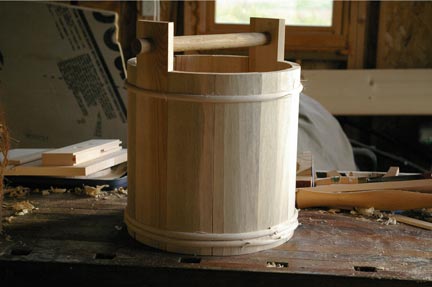
My stave bucket
For almost 2000 years the stave vessel has been a mainstay for household items, food and drink production and storage, and commerce.
This straight sided pine vessel, based on the ambar, will be used as a bucket to carry water. (Right now the vessel leaks through the bottom. I did not use any reeds to make the joints water tight, but I harvested some cat tails for reeds. Hopefully, they will seal the bottom joints. The sides swell when wet and appear to seal these joints.)
Not only shaping our culture and society through the ages, these stave vessels are also works of art combining form and function with beauty and art.
August 2013 Item of the Month Bere Barley
The August 2013 Item of the Month is the bere barley, the barley of the Vikings
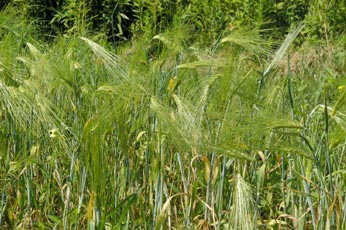
My bere barley, the barley of the Vikings (picture taken in early July)
Bere, pronounced bear, is a six row barley grown by the Norse in Viking Age Norway, the Shetlands, and the Orkneys. Bere was also called bygge or big which might have come from bygg which is old Norse for barley. It has a short growing season, about 90 days, making it the last crop sown in the spring and the first harvested in the summer. Bere grows well in cool, wet climates with long hours of daylight, well matched to Scandinavia and Scotland. However, it tends to lodge and has a small yield compared to modern barley. Recently, the Agronomy Institute in Orkney Scotland has a research program on bere, and Barony Mills, a 19th century watermill, purchases the grain to produce beremeal to be used locally in bread, biscuits, and beremeal bannock. It is also used today in making bere beer and whiskey.
I first encountered bere at Jarlshof in the Shetlands where I tasted the beremeal bannock and the bere beer. The beer was very smoky, reminiscent of some Scotch whiskey.
I wanted to grow some bere at our longhouse, but I could not import seeds from the Orkneys. I found seeds available from a company in Canada, but customs confiscated the seeds at the border, and all I got was an empty envelope with a note from customs. Eventually I found an archival seed company in Oregon, and purchased 3 heads of bere.
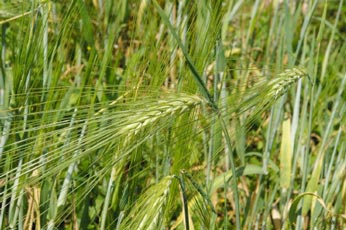
A close up of bere showing the six rows
This is my second year growing bere. The first year I got maybe a hundred heads. This year looked promising, but I am afraid the heads did not fill well because it was too dry for bere. Next week I will go and harvest my bere, but Im not optimistic. I did hold back some grain from last year so even if this year does not have a good yield I might still have some seed for next year (although the germination rate will decrease).
Eventually I would like to be able to grow enough bere to make some bread and beer. Wish me luck, but I expect it will take several years to build up my bere crop to those levels.
July 2013 Item of the Month
The July 2013 Item of the Month is the flea catcher, the Brides edging on a Skinnfell
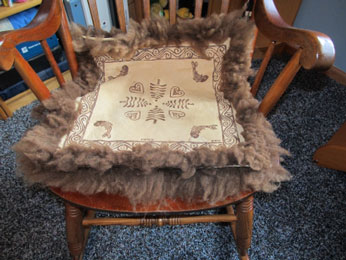
Skinnfeller are traditional Norwegian bed coverings made from sheep skins sewn together into a rectangular form to fit a bed.1 Origins of skinnfeller predate written history, and probably go back past the Viking Age. There are references to bed coverings in the Norse sagas,2,3 but it is not clear whether they were sheep skins or wool, or both. There are also references to sleep bags, hudfat, made from sheep skins sewn together. Today skinnfeller in Norway are highly valued because of their tradition, beauty, and the cost of the sheep skins and the large amount of labor necessary to make a skinnfell.
The skinnfell are decorated by printing with wood blocks where the designs represent nature sun, water, plants, animals and protection mostly geometric patterns. The skinnfell are edged with either goat skin, the everyday edging, or with sheep skin strips, the brides edging. The brides edging is a narrow strip of fur aligned with the other edge of the skinnfell, and sewn to the sheep skin on the inside of the strip creating a skin to skin interface open on the outer edge of the skinnfell. The brides edging is also called a flea catcher, so it has function and form.
In both Norway and among Norse descendants in the United States, skinnfeller today continue to be highly valued and used, with more people learning how to make these ancient objects of beauty and warmth.
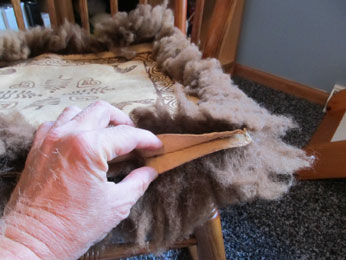
1 Solheim, Britt. Skinnfeller. 2011. Cappelen Damm As. 2 Orkneyinga Saga.1978. trans Hermann Palssson. Hogarth Press. 3 Droplaugarsona saga 1876. Fr. Winkel Horn trans (Danish from the original Icelandic) Icelandic Saga Database, http://sagadb.org/ Accessed 6/6/2013.
June 2013 Item of the Month
The June 2013 Item of the Month is a Viking Age Vinland/Greenland drop spindle.
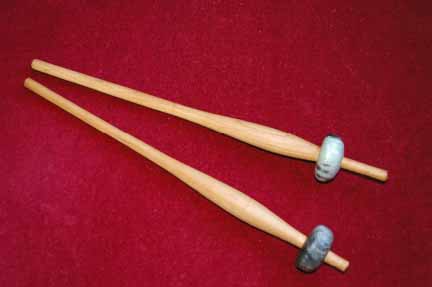
Figure 1. The Greenland/Vinland drop spindle.
The spinning whorl found at LAnse aux Meadows indicates that the settlement was Norse because of the similarity with spinning whorls used in Greenland about 1000 AD.i,ii (The making of iron, an iron boat nail, the long house shape, a glass bead, lamp or door pivot stone, and the bronze ringed pin also indicated that the settlement was Viking.iii)
The spinning whorl is placed on a spindle, either toward the top or toward the bottom. The top-whorl spindle is set in motion by rolling down ones hip or leg, and the bottom whorl spindle is set in motion by a flick of the fingers.iv Depending on the direction you spin you produce a Z-spun or an S-spun thread.
The spinning whorls are typically conical, hemispherical, or spherical. The spindle whorl found at LAnse aux Meadows resembles those used in Greenland, a slightly flattened spherical shape 33 mm in diameter.v,vi Spindle whorls ranged from 25 to 85 mm in diameter, and weighed 12 to 90 grams. The spindles or shafts ranged from about 170 to 400 mm long, 7 to 16 long, with a thickening towards one end.vii,viii
The spindle and the spinning whorl can both be turned, with about a quarter of the Viking spinning whorls from York being turned.ix I make my spindles out of maple and alder, and the spinning whorls out of soapstone. The following figure shows several typical Norse spinning whorls.
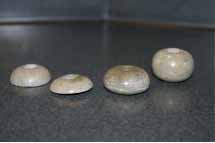
Figure 2. Typical Norse spinning whorls.
The whorl on the left is hemispherical with the flat side placed upwards for a bottom-whorl spindle. The second whorl from the left is hemispherical with a slightly convex surface that forms the top, hemispherical-convex. (A more accurate description is plano-convex for the first whorl since the curved surface ranges from bun shaped to hemispherical. But then the second whorl would then be convex-convex which I dont think is as descriptive as hemispherical-convex, although probably more accurate.) The 3rd whorl from the left is the LAnse aux Meadow/Greenland whorl, a slightly flattened spherical whorl. The whorl on the right is spherical.
The spinning whorl at LAnse Aux Meadow indicates the Norse presence in North America, and it also confirms the accounts of the sagas that women were present on the Vinland expeditions.
i Helge Ingstad and Anne Stine Ingstad, The Viking Discovery of America, The Excavation of a Norse Settlement in LAnse aux Meadows, Newfoundland, Checkmark Books, 2001, pages 156-157.
ii Birgitta Linderoth Wallace, Westward Vikings, The Saga of LAnse aux Meadows, ©Birgitta Linderoth Wallace, Parks Canada, and Historic Sites Association of Newfoundland and Labrador, 2006, page 68.
iii Wallace, pages 38-52, 56, 63, 68, 71
iv Else Ostergard, Woven into the Earth, Textiles from Norse Greenland, Aarhus University Press, 2004, pages 46-47.
v Wallace, page 68.
vi William W. Fitzhugh and Elizabeth I. Ward, Vikings, The North Atlantic Sage, Smithsonian Institution Press, Washington and London, 2000, page 338.
vii Ostergard, pages 49 and 51.
viii Carole A. Morris, Wood and Woodworking in Anglo-Scandinavian and Medieval York, Published for the York Archaeological Trust by the Council for British Archaeology, Vol 17: The Small Finds, Fasc. 13. Craft, Industry, and Everyday Life, ISBN 1 902771 10 9, 2000, pages 2331-2333.
ix http://www.stringpage.com/viking/spindles.html references Walton Rogers, P. 2000. Stone spindle whorls. Pp. 2530-2533 in: A.J. Mainman and N.S.H. Rogers. Craft Industry and Everyday Life: Finds from Anglo-Scandinavian York. Vol 17: The Small Finds, Fasc. 14. York Archaeological Trust.
May 2013 Item of the Month
The May 2013 Item of the Month is a Viking Age Greenland soapstone lamp.These lamps were used to light the interior of Viking Age longhouses.
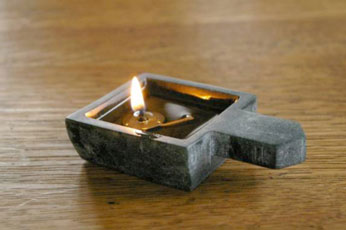 The lamp is made from soapstone using a saw, files, and chisels. This lamp is rectangular with a tab to allow one to pick it up. The rectangular oil reservoir is 2 ½ by 2 ½ (about 60 mm square) and 7/8 high (about 20 mm high) with a ½ deep oil reservoir chamber. The lamp is based on a photograph at the Narsarsuaq Museum of a Greenland soapstone lamp, but I believe that actual lamp is in a museum in Denmark.
The lamp is made from soapstone using a saw, files, and chisels. This lamp is rectangular with a tab to allow one to pick it up. The rectangular oil reservoir is 2 ½ by 2 ½ (about 60 mm square) and 7/8 high (about 20 mm high) with a ½ deep oil reservoir chamber. The lamp is based on a photograph at the Narsarsuaq Museum of a Greenland soapstone lamp, but I believe that actual lamp is in a museum in Denmark.
The photograph at the museum calls the lamps blubber lamps. Cotton grass, a plant found in Norway, Shetland, Iceland, Greenland, and Newfoundland, could have been used as a wick, although other fibers will also work. I do not have blubber so I burned olive oil, and I dont have any cotton grass growing here in Wisconsin yet so I used a modern lamp wick and a modern wick tab to hold the wick vertical away from the walls of the oil reservoir so the oil doesnt wet the walls of the lamp. The amount of light produced is large for such a small wick and lamp.
Eat Like A Viking
A listing of Eat Like a Viking Talks
Viking Chest Details
Ive put together a talk based on my turning projects, which I call Eat Like a Viking. The title is from one of these emails where I talked about turning replica Viking bowls, and where if you Eat Like a Viking you would eat out of a bowl.
April 2013 Item of the Month
Since this is the first Item of the Month, I will start it with some pictures of the Sons of Norway District 5 Traveling Viking Chest.
District 5 Traveling Viking Chest
The Sons of Norway D5 Traveling Viking Chest is complete. It is similar to and was inspired by the chest I bring to my Scandinavian turning talks. (This is an evolution and synthesis of my Viking chest for my turning talks with an idea suggested by Burt Bittner three years ago to encourage cultural skills.)
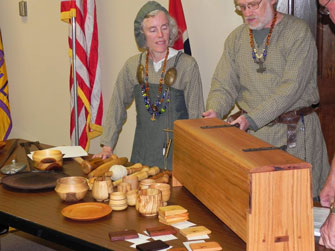
Here is the Traveling Viking Chest.
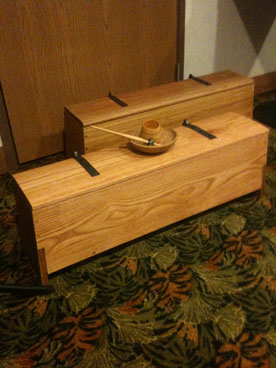
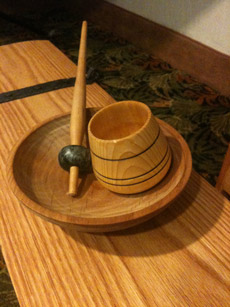
The chest is seeded with a Viking drop spindle, a Viking bowl, and a Viking cup.
The Traveling Viking Chest will be in the possession of the zone directors. The Chest will travel from zone to zone being exchanged at our board meetings. The zone director will take the Chest to their lodge meetings. Each lodge should make a reservation with the zone director. Each lodge would be asked to add one new item to the box, and a written description, as their rent. The item could consist of some craft, or even a recipe or photo, or something written, whatever a lodge thinks others might be interested in seeing.
Eventually, the box will fill up, at which point I will make another box. We will split the box and now have two traveling Viking chests. Hopefully the Traveling Viking Chest will inspire a sort of competition between lodges to add beautiful crafts or objects to the chest. Each time the chest is opened it will be different because the contents keep changing and increasing.
The board will have to set up a schedule for the chest to alternate between zones. Gary Melby has the chest first for suggesting zone directors transport the Chest between lodges.
My committee recommended that I send either an email or letter to each lodge describing the chest, and explaining how the chest will move from zone to zone and lodge to lodge so that lodges can begin the reservation process. My committee also recommends that I keep the schedule up on the D5 website, and that I keep a list of items in the chest also on the website.
Schedule:
April to October 2013 Zone 5 Gary Melby and Tom Maxson
October 2013 to April 2014 Zone ?
Talk to your Zone Director to schedule a visitation with the Traveling Viking Chest

This is an example of how Polar Star Lodge members earned the most District 5 cutural pins two years in a row.
